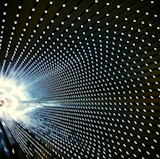I.M. Pei, Luce Memorial Chapel (1963)
When architect I.M. Pei designed this chapel for Tunghai University in Taiwan, he had to take local conditions, like typhoons and earthquakes, into account. His plan, which, included a curved roof of glazed, diamond-shaped tiles and interior ribs of reinforced concrete that run like ribbons towards the cross mounted on the roof, was an elegant solution to the challenges of the local environment.
Photo courtesy Valter Wei, Creative Commons
Photo from blackandwtf.tumblr.com
The sunken living room is just one of many grade changes inside the structure. “We were adamant that we didn’t want something domestic,” says Andrew. “We wanted something surprising, that was hyper-animated, and that, when you moved through it, changed all the time.” The sofa, designed by the couple and Levenbetts, is upholstered in cotton velvet. The Habibi side tables are by Philipp Mainzer for e15, the fireplace tools by Fort Standard, and the doors by Fleetwood.
The colors used in the interior were inspired by the surrounding landscape. The kitchen island is clad in solid timber fluting crafted from durable plantation-grown iroko with with a granite top. “The green-blue-brown color of the granite benchtops very much reminded me of the colors of the water in the nearby harbor of Tutakaka,” says architect Belinda George.
"A well-performing house extension facing south on a small inner-city block built in rammed earth is not easy to achieve," said Welsch. "However, in this challenge was our opportunity: We decided that our extension will curl around to capture the sun, creating a communal courtyard and allowing the occupants to look at their own house rather than a paling fence."
Bestor consulting with her demolition crew, in her kitchen-to-be. I'm hoping to get Bestor blogging about her renovation on Dwell.com—so stay tuned for that!
11.3k more photos



































